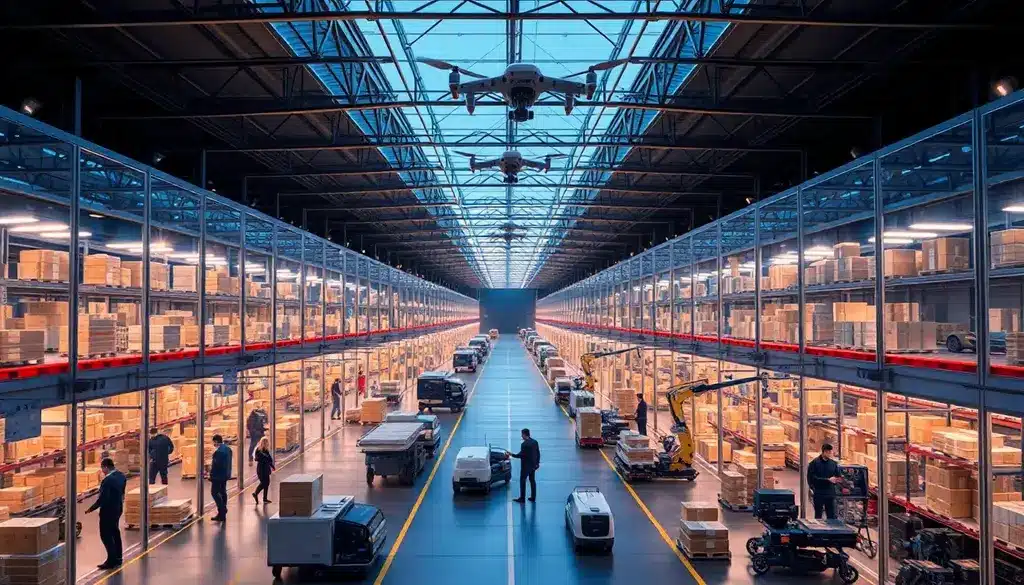
3PL stands for third-party logistics and is a system used in supply chain management. It involves the outsourcing of transportation, warehousing, and distribution activities to a third-party provider. This can be beneficial for companies who want to focus on their core business functions and leave the logistics to someone else.
In this guide, we will discuss what a 3PL is, what it means in warehousing, the different types of 3PL providers, and how it differs from 4PL and freight forwarding.
What is a 3PL (Third-Party Logistics) Provider?
A third-party logistics provider is a company that provides transportation and warehousing services to its customers. These services are often bundled and may include cross-docking, inventory management, packaging, and freight forwarding. These services can be provided by the same company or by different companies. The term “third-party” refers to the fact that the provider is not part of the company’s internal operations.
What is a 3PL (Third-Party Logistics) System?
A 3PL system (also known as a “third-party logistics network” or “TPN”) is a network of transportation and warehousing providers that work together to provide services to their customers. The system is made up of three components: carriers, shippers, and service providers. They are often linked by software to be able to exchange information in real time.
What is 3PL in Supply Chain Management?
Third-party logistics in supply chain management is the outsourcing of transportation, warehousing, and distribution activities to a third-party provider. As mentioned above, this allows manufacturing companies to focus on their core business activities and to let someone else manage the supply chain functions.
The Advantages 3PL Partners Provide
There are several advantages that a company can enjoy by partnering with a 3PL provider. These advantages include:
- Access to Resources: 3PL providers have access to resources that companies may not have, such as transportation fleets, warehouses, and distribution networks. This can be beneficial for companies who want to outsource their logistics but do not have the resources to do so.
- Cost Savings: 3PL providers can often provide cost savings to companies by economies of scale and access to discounts on shipping costs.
- Flexibility: 3PL providers can be flexible in their services, which can be beneficial for companies that have fluctuating needs.
- Risk Management: 3PL providers can help companies manage risk by providing insurance and other services.
Potential Disadvantages of 3PL
There are also some potential disadvantages that companies should be aware of when considering partnering with a 3PL provider. These disadvantages include:
- Loss of Control: When a company outsources its logistics to a third-party provider, it may lose some control over the process. This can be an issue if the company is not happy with the service, the 3pl provider does not provide accurate and on-demand reporting, or if the company cannot see its inventory and order status in real time.
- Dependence on the Provider: If a company outsources its logistics to a third-party provider, it may become dependent on the provider for transportation, warehousing, and distribution services. This can be an issue if the provider is unable to meet the company’s needs or if there are problems with the provider.
- Contractual Obligations: When a company outsources its logistics to a third-party provider, it may be required to sign a contract with the provider. This can be an issue if the company is not happy with the service or if there are problems with the provider.
The Different Services Provided by 3PL Companies
Third-party logistics companies offer a variety of transportation, warehousing, and distribution services. These services can include:
Transportation Management
Transportation management is the process of planning, coordinating, and executing the movement of goods. This can include tasks such as booking space on ships and airplanes, customs clearance, and tracking.
Warehousing Management
Warehousing management is the process of storing and managing goods in a warehouse. This can include tasks such as receiving, storing, and shipping goods.
Distribution Management
Distribution management is the process of distributing goods to customers. This can include tasks such as order fulfillment, inventory management, and transportation planning.
Pick and Pack Services
A pick-and-pack service is a type of distribution service in which the provider picks, packs, and ships products on behalf of their customer. This can include tasks such as order fulfillment, inventory management, and transportation planning. It is common for an eCommerce store to partner with pick-and-pack services for its eCommerce fulfillment.
Cross Docking
Cross-docking is where products are unloaded from inbound trucks and loaded directly onto outbound trucks, without being stored in the warehouse. It is most often used for products with a short shelf life, that are time sensitive, or in high demand.
Inventory Management Services
An inventory management service is a type of service that helps companies manage their inventory. This can include tasks such as stock control, order fulfillment, and transportation planning. Inventory management services are often used by companies that have complex supply chains.
Individualized and Customized Storage Services
 Different companies have different storage needs. Some companies may need temperature-controlled storage, while others may need hazardous materials storage. 3PL providers can offer customized and individualized warehouse storage services that meet the specific needs of their customers.
Different companies have different storage needs. Some companies may need temperature-controlled storage, while others may need hazardous materials storage. 3PL providers can offer customized and individualized warehouse storage services that meet the specific needs of their customers.
These are just some of the services that 3PL providers can offer. The specific services provided by a particular provider will depend on their areas of expertise and their clients’ needs.
The 3PL Fulfillment Process
Order fulfillment is a common service provided by 3PLs. The exact fulfillment services offered vary between providers. However, most 3PLs perform these basic fulfillment services:
Receiving
The first step in the third-party logistics fulfillment process is receiving orders from customers. Orders can be received via phone, email, or an online ordering system.
Picking
Once an order is received, the next step is to pick the products that are being ordered from within the fulfillment center. This involves retrieving the products from storage and getting them ready for shipping.
Packing
The next step is to pack the products into boxes or containers. This helps to protect the products during shipping and makes it easier to track orders.
Shipping
 The final step in the third-party logistics fulfillment process is shipping the products to the customer. This can be done via the postal service, UPS, FedEx, or another shipping company. Some 3PLs have their own fleets for making local or regional deliveries. Once the products have been shipped, the order is considered complete unless the 3PL is also making the delivery.
The final step in the third-party logistics fulfillment process is shipping the products to the customer. This can be done via the postal service, UPS, FedEx, or another shipping company. Some 3PLs have their own fleets for making local or regional deliveries. Once the products have been shipped, the order is considered complete unless the 3PL is also making the delivery.
What is the Difference Between 3PL and Freight Forwarding?
Freight forwarders are companies that specialize in arranging transportation for shipments between one location and another. This can be via ground, sea, or air freight. A 3PL provider is a company that provides a variety of logistics services, which may include transportation, warehousing, and customs.
These services tend to overlap with those of a freight forwarder. However, 3PL providers typically offer other logistics services beyond those of freight forwarders.
What are the Different Types of 3PL Providers?
Amongst 3PLs, different companies focus on different areas of expertise and the level of service offered. Originally, the term “3PL” was first used to recognize intermodal marketing companies (IMCs) in transportation contracts in the 1970s. Prior to then, transportation contracts featured only two parties, the carrier and the shipper. After IMCs became involved as intermediaries, they received shipments from the shippers and transferred them to rail carriers. With this move, they assumed the position of a third party to the contract—the “3PL.”
Over time, the definition of a 3PL has expanded to the point where nearly every business that offers some logistics service for hire identifies itself a 3PL! Ideally, the various logistics services are bundled together by the provider and may include: transportation, warehousing, inventory management, packaging, cross-docking, and freight forwarding.
To clarify things, in 2008, the Consumer Product Safety Improvement Act legislation was passed. The Act declared that the legal definition of a 3PL is an entity “who solely receives, holds, or otherwise transports a consumer product in the ordinary course of business but who does not take title to the product.”
Defining 1PL, 2PL, 3PL, and 4PL/5PL
In both the logistics and supply chain industries, there are different terms that identify who is providing the service. Let’s go over these here.
First-Party Logistics Provider (1PL)
A 1PL is a company that provides logistics services to its own organization. This is the in-house shipping and receiving department for a company.
Second-Party Logistics Provider (2PL)
A 2PL is a company that is responsible for the transportation of goods. This can include shipping lines, airlines, and hauling companies. Since many companies do not want to maintain fleets of trucks, rail cars, and airplanes, it is common to outsource transportation.
Third-Party Logistics Provider (3PL)
A 3PL provider offers logistics services to organizations on an as-needed basis. These services are typically transportation, warehousing, and fulfillment. In this case, the 3PL becomes an additional warehouse and shipping (and sometimes receiving) operation for a company. The 3PL may provide additional services such as returns processing and kitting. They may also break pallets and cartons to offer “each item” fulfillment.
Fourth- and Fifth-Party Logistics Provider (4PL/5PL)
A 4PL/5PL provider typically integrates and manages all aspects of the supply chain for clients. This includes things like IT, procurement, and finance. These higher-end logistics solutions will oversee the supply chain for clients from beginning to end.
These 4PL/5PL providers tend to offer more customized services and will often manage multiple outsourced service providers via their integrated IT and computer systems.
What is the Difference Between 3PL and 4PL/5PL?
A 3PL can be similar to a 4PL/5PL but they often have different levels of service. A 4PL/5PL provider typically takes on a more active role in managing the supply chain and the assets of its client.
This can include tasks such as planning, coordination, and execution. 4PL/5PL is typically used by larger companies that have complex supply chains.
Potential Advantage of 4PL/5PL Providers
A benefit that 4PLs/5PLs can provide is a long-term, strategic relationship focused on delivering a higher degree of service at the best value. A 4PL/5PL also offers a single point of contact throughout the supply chain and ensures all participants have the right level of visibility.
When To Use 3PL Services For Warehousing And Distribution?
There are several factors that companies should consider when deciding whether or not to use 3PL services for warehousing and distribution. These factors include:
The Company’s Needs
The company should consider its needs for transportation, warehousing, and distribution services. If the company does not have the resources to handle these activities itself, then it may be beneficial to use a 3PL service.
The Company’s Budget
The company should consider its budget for the services just mentioned. If the company is not able to afford to build out the necessary facilities or hire the additional staff required, then using a 3PL service may be the best option.
The Company’s Goals
The company should consider its core business objectives. If transportation, warehousing, and distribution are outside of these goals, and have little impact, then it may be beneficial for the company to outsource these activities by contracting with a 3PL service.
The Company’s Location
The company should also consider its location. If the company is located in an area that is not served by many transportation options, then using a local or regional provider with better access to transportation hubs may be the best option. It is also useful to have products located close to the customer base to offer fast and economical delivery options.
How 3PLs Help Clients Save Time and Money
3PL providers can help companies save time and money by managing tasks such as transportation, warehousing, and distribution. Outsourcing these activities lets companies focus on their core business functions and leave the logistics to someone else.
Reduce Initial Costs
By using an outside fulfillment center, you eliminate the need to spend money on renting warehouse space, hiring labor, and other logistical operations.
Avoid Growing Costs
Logistics can become increasingly expensive as a client’s business grows. These costs include warehouse space, warehouse equipment, warehouse management system (WMS) software, labor costs, workers comp., and liability insurance. A 3PL company manages the storage and distribution of your products, so you don’t have to.
Save Time
A 3PL not only saves money but time as well. Clients avoid tedious tasks such as packing boxes and shipping orders one by one. This allows them to focus on other things that are important to their company, like developing new products or marketing strategies.
How Do Logistics Providers Add Value?
 We’ve already mentioned many of the advantages and benefits provided by 3PLs. They add value by managing and improving the flow of goods, information, and money across the supply chain from raw materials to the end customer.
We’ve already mentioned many of the advantages and benefits provided by 3PLs. They add value by managing and improving the flow of goods, information, and money across the supply chain from raw materials to the end customer.
Software programs, especially a WMS, are used by 3PL companies to improve their efficiency in tasks such as transportation management, warehousing management, and distribution management. This leads to greater efficiency, cost savings, and increased customer satisfaction.
What Software is Used by 3PL Companies (WMS, ERP, SCM)?
The specific software used by a particular provider will depend on their areas of expertise and their clients’ needs. However, some of the most common software used by 3PL and 4PL providers include:
- Warehouse Management System (WMS): A warehouse management system is software that helps companies manage their warehouses. This can include tasks such as stock control, order fulfillment, and transportation planning. A WMS designed to meet the needs of a 3PL business will include additional features such as activity billing, web access to inventory, and cost accounting.
- Enterprise Resource Planning (ERP): An enterprise resource planning system is software that integrates and manages all of a business’s processes. This can include tasks such as accounting, human resources, and supply chain management.
- Supply Chain Management (SCM): A supply chain management system is a set of tools that oversees the entire supply chain logistics from production to delivery. This system tracks data, goods, and assets as they move from production to customer.
How Argos’ Software Helps 3PL Providers
Argos is a WMS and ERP Software in one. It offers a variety of software solutions that help 3PLs with tasks such as transportation management, warehousing management, and distribution management.
A flexible, modular solution, Argos Software includes core accounting with modules that handle all the aspects of order management, inventory management, transportation management, and business management.
Our professionals will help you design the system that meets your needs today and provide a roadmap for future growth.
For more information about how Argos Software can help your business, please contact us today.
Conclusion
A third-party logistics provider is a company that provides logistics services to organizations on a fee-for-service basis. 3PL providers can provide a variety of services, including order entry, order processing, picking and packing, shipping, invoicing, and customer service. The main advantage of using a 3PL provider is that it allows organizations to outsource their logistics operations.
If you’re looking for warehouse management software to help streamline your third-party logistics operations, look no further than Argos Software. Our WMS is designed to provide you with the tools you need to manage your inventory, orders, and shipping efficiently and effectively. Contact us today to learn more about our third-party logistics solutions.
FAQs
What is a 3PL Company and What is Warehousing 3PL?
A third-party logistics provider is a company that provides logistics services to organizations on a fee-for-service basis. Third-party logistics providers can provide a variety of services, including order entry, order processing, picking and packing, shipping, invoicing, and customer service.
What is the Difference Between a Third Party Logistics Company and a Freight Forwarder?
A freight forwarder is a company that provides transportation services for businesses. A third-party logistics company is a company that provides logistics services to businesses.
The main difference between a freight forwarder and a third-party logistics company is that a freight forwarder only provides transportation services, while a third-party logistics company can provide a variety of services, including transportation, warehousing, and order fulfillment.
What is a 3PL Inventory System?
A 3PL inventory system is a software system that helps track and manage what goes on in a warehouse. This includes managing physical inventory, picking, packing, and processing returns, as well as optimizing the picking pattern. Look no further than Argos Software WMS for advanced 3PL inventory management.
Is Amazon Considered a 3PL?
Yes, Amazon is considered the largest 3PL company in the world. Millions of businesses rely on Amazon’s massive infrastructure to provide eCommerce fulfillment for their customers.
What is a Non-Asset-Based 3PL Company?
A non-asset-based 3PL company is a management company that does not own any trucks, warehouses, or other transportation equipment. Instead, they have relationships with other companies to provide these services. The result is, non-asset based 3PLs are able to be flexible with their solutions because they are not tied to using specific warehouse locations or their own trucks like an asset-based 3PL might.
What is a Lead Logistics Provider?
A lead logistics provider (also called a “4PL” or “LLP”) is a logistics industry provider that takes on a more active role in managing the supply chain for its clients. This can include tasks such as planning, coordination, and execution.
What is a 3PL Warehouse?
A 3PL warehouse (also known as a “third-party logistics center” or “TPLC”) is a third-party warehouse that is owned and operated by a 3PL provider. These warehouses are used to store inventory for companies that have outsourced their warehousing, transportation, and distribution needs to the provider. They are also referred to as public warehouses because they are not exclusive or in-house warehouses for a specific company but typically have multiple clients or customers.
3PL Services vs. Dropshipping: What’s the Difference?
Dropshipping is a type of eCommerce fulfillment in which the seller does not keep products in stock. Instead, when a customer orders a product, the retailer will contact the supplier and have the supplier ship the product directly to the customer. The main advantage of dropshipping is that it allows retailers to sell products without having to carry inventory.
The main difference between dropshipping and using a 3PL provider is that with dropshipping, the retailer is responsible for managing the relationship with the manufacturer or supplier. However, when partnering with a 3PL provider, the 3PL is responsible for managing the relationship with the supplier.




